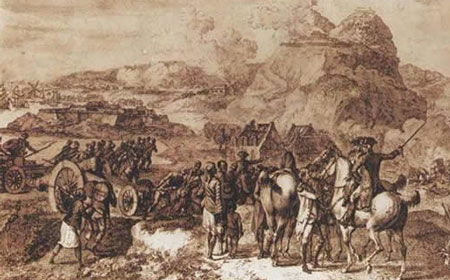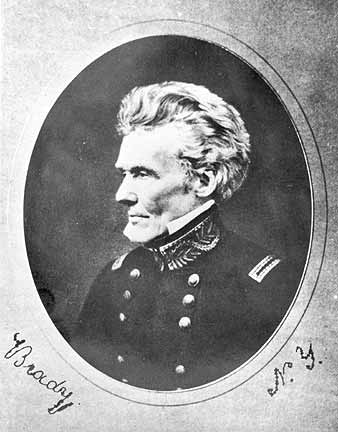<Back to Index>
- 11th Governor of West Florida José Masot, 1700+
- Major General of the U.S. Army Edmund Pendleton Gaines, 1777
PAGE SPONSOR

José Masot, also known as José Fascot, was a Spanish soldier and commander who was Governor of West Florida from 1816 - May 26, 1818. He was West Florida's governor through much of the First Seminole War, until he was deposed by American general Andrew Jackson and replaced with William King.
José Masot born between the late eighteenth and early nineteenth century. He spent his youth as a soldier of the Spanish Navy, but his talent in the Army promoted him to the post of Colonel. He was appointed governor of West Florida in 1816. During his governorship, there was an uprising of black slaves, which was severely punished.
He governed West Florida during the First Seminole War, during which United States forces entered the region repeatedly. On November 11, 1817 several officers and cadets of the Infantry Regiment of Louisiana´s Fixed, met in Pensacola, in home of Lieutenant Henry Grandpre, and they decided to kill the governor and give the command to commander Luis Piernas or to artillery colonel Diego Vera. The plot was discovered, but Masot send news of what happened to Captain General of Cuba (in the Spanish empire, Florida was governed by Cuba) who suspected him of a certain relationship between the conspirators and the American troops that had entered the territory of the Apalachicola and whose number is estimated at nearly 4,000 men. He feared that it would produce a similar situation to that produced in Baton Rouge and Mobile. The day 24 of 1819, the American occupied the square of Florida's capital, Pensacola, and, after a confrontation with gunfire that lasted several days, Masot gave up in 1828 and he formally handed West Florida to the armed forces of United States. in fact, the Spanish commander gave all he had. With the capture of Pensacola, Andrew Jackson ended his campaign and Colonel William King was appointed as governor of West Florida and American troops returned to the U.S.

Edmund Pendleton Gaines (March 20, 1777 – June 6, 1849) was a United States army officer who served with distinction during the War of 1812, the Seminole Wars and the Black Hawk War.
Gaines was born in Culpeper County, Virginia on March 20, 1777. He was named after his great uncle Edmund Pendleton, who was the political leader of Virginia during the Revolution. Edmund's father, James, had been captain of a company in the American forces during the Revolutionary War, and after the war his family moved to North Carolina, where his father became a state representative. He enlisted in the army in 1799 and was a first lieutenant by 1807.
In the early 19th century, Gaines surveyed routes and boundaries in the Mississippi Territory including parts of the Natchez Trace. In 1807, Gaines was the commandant of Fort Stoddert. During this time, he arrested Aaron Burr at Wakefield, Alabama, and testified at his trial. Gaines also surveyed the route that would become the portion of the Gaines Trace from the Tennessee River to Cotton Gin Port, Mississippi. He afterwards took a leave of absence from the army to practice law.
The War of 1812 brought Gaines back to the army and was appointed major of the Eighth U.S. Infantry and in July, 1812, was made a lieutenant colonel in the Twenty - Fourth U.S. Infantry. In 1813, he was promoted to colonel and commanded the Twenty - Fifth Infantry with distinction at the Battle of Crysler's Farm. He became adjutant general and was with General William Henry Harrison's army at the Battle of the Thames. He was promoted brigadier general of regulars on March 9, 1814 and commanded the post at Fort Erie after the U.S. capture. General Jacob Brown was wounded at the Battle of Lundy's Lane and when the U.S. Army of the Niagara returned to the fort, command was passed to Gaines. At the Siege of Fort Erie, Gaines was in command on the fortifications on 15 August 1814, when a British assault was bloodily repulsed. For this victory - the First Battle of Fort Erie - Gaines was awarded the Thanks of Congress, an Act of Congress Gold Medal (outranking a Congressional Medal of Honor, according to the Smithsonian), and a brevet promotion to major general. General Gaines was seriously wounded by artillery fire and General Brown, having recovered, returned to command. Gaines' wound ended his active field career for the rest of the war, and he was given command of the Military District Number 6.
At the end of the war, Gaines was sent as commissioner to deal with the Creek Indians. The U.S. commanding general, Jacob Brown, died in 1828; and Gaines was one of two ranking generals who could have been considered for the post. However, he and the other general, Winfield Scott, had both publicly quarreled with each other, and Alexander Macomb was promoted over both of them. He commanded the Western Military Department during the Black Hawk War. He was still in command of the department during the Seminole Wars in which he personally led an expedition. At the Battle of Ouithlacoochie he was wounded in the mouth.
1n 1830, Gaines opposed President Andrew Jackson's policy of Indian removal.
On February 20, 1836, Gaines and his men were the first U.S. soldiers to revisit the scene of the Dade Massacre, where they identified and interred the bodies.
In 1836, he was placed in command of the Southwest Military District. He was given instructions to fortify the border of the Louisiana Territory and Texas in the case that the Mexican army might threaten U.S. territory. He was also given orders to post guards preventing any U.S. soldiers from crossing into Texas and fighting in the rebellion. He was in command of the Army's Western Division at the outbreak of the Mexican - American War. He was reprimanded by the U.S. government for overstepping his authority by calling up Louisiana volunteers for Zachary Taylor's army. He nevertheless called up volunteers from other southwestern states and received a court martial but was able to successfully defend himself.
In the years during and following the Mexican - American War, Gaines was in command of a series of military districts. He was in command of the Western Division when he died at New Orleans, Louisiana, on June 6, 1849. He was interred in the Church Street Graveyard in Mobile, Alabama.
A number of places in the United States were named in his honor, including Gainesvilles in Florida, Texas, and Georgia; Gaines Township in Michigan; and Gainesboro in Tennessee. He was also the namesake of Gaines Streets in Tallahassee, Florida, and Davenport, Iowa; and Fort Gaines, a historic fort on Dauphin Island, Alabama.